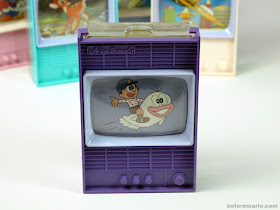The most spectacular games in the Nintendo
Game & Watch series are the
Panorama and
Table Top games. Combining the excellent LCD based game-play that shines throughout the entire series with full color images, these were innovative as well as fun to play.
The
Table Top games were shaped like mini arcade cabinets, with joystick and all. In the 80s, owning one of these must have been close to being in handheld nirvana.
 |
| Nintendo Color Screen (a.k.a. Table Top) from 1983 |
The original name under which these games were sold in Japan was
Color Screen (カラースクリーン), with strangely enough no reference to
Game & Watch, although they are clearly part of that family. They were introduced in the rest of the world as
Game & Watch Table Top.









